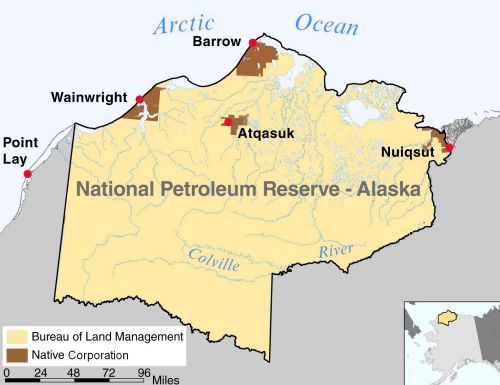ConocoPhillips expects peak production of 16 MBOPD from National Petroleum Reserves
Oil began to flow for the first time from Alaska’s National Petroleum Reserves this week since President Warren G. Harding dedicated the resources as an emergency supply of oil for the U.S. in 1923. The North Slope project, operated by ConocoPhillips (ticker: COP, ConocoPhillips.com), is expected to produce 16 MBOPD from the Colville-Delta 5 (CD5) field, and will serve as a launch pad for other nearby fields in Alaska’s Arctic, according to a report from the Associated Press.
Originally called the Naval Petroleum Reserve No. 4 before being renamed National Petroleum Reserve-Alaska (NPR-A), the reserve includes 22.8 million acres. The land was set aside as an emergency oil supply for the U.S. Navy in 1923 and then transferred to the Bureau of Land Management in 1976.

Source: BLM
“We’ve spent more than a dozen years trying to achieve the permits to do the development, to complete the development,” Jim Brodie, the capital projects manager for ConocoPhillips in the reserve, said of the $1 billion project earlier this month. “It’s a sizable investment.”
The project included a 6-mile gravel road, four bridges over channels of the Colville River, including one 1,400 foot expanse, 32 miles of pipelines, and miles of communications and electrical infrastructure that tie the field back to the main Alpine facilities. The oil produced at the project is being sent to Alpine for processing, and then sent 800 miles down the trans-Alaska pipeline for shipment out of Valdez.
The development required a great deal of cooperation with the local Nuiqsut community. Village residents objected to one of the bridges initially, worrying that it would interfere with fishing access. Brodie said ConocoPhillips pulled its permits and reworked the development plan with the local community in order to find a compromise.
The reworked deal “established a new location for the Nigliq Channel Bridge, which caused a reroute of the road and it was at considerable expense to ConocoPhillips but at the same time we got the support from the community and it enabled the project to move forward.”
“We worked with ConocoPhillips to make sure that CD5 is developed responsibly and make sure that it’s a win-win,” said Isaac Nukapigak, president of Kuukpik, an Alaska Native village corporation for the Nuiqsut community.
Less environmental concern than typical projects
This project has not drawn the same scrutiny as other developments in Alaska. Nicole Whittington-Evans, Alaska regional director for The Wilderness Society, said her group has been mostly concerned with how the development will proceed.
Roads, and how far west the development might continue to grow— “those are the types of things that we’re concerned about right now, and we have focused on trying to ensure that the least environmentally damaging developments move forward,” she said.
The future of Alaska’s oil development
ConocoPhillips continues preparations to drill at its Greater Mooses Tooth 1 project despite the current price of oil. First oil from that project could come as soon as December 2018, and could produce 30,000 barrels a day at peak production.
Steve Thatcher, COP’s Alpine operations manager, said prices will rebound, and he said the company continues to invest in new production.
“For these kinds of projects, if we can invest in them now, it makes a lot of sense for when the oil price is the other extreme,” he said.
Lower oil prices took a tremendous toll on Alaska, which relies on oil revenues to fund its budget. Because of the budget gap emerging, Governor Bill Walker suggested a fiscal 2017 budget to address the state’s $3.5 billion budget deficit through spending cuts, new revenue, wealth management and investment.
“This is a major paradigm shift in how the State of Alaska conducts business,” said Walker. “Never before has the state faced a deficit so large that we are draining more than $9 million from savings every day.”
These large-scale onshore projects could offer new sources of tax revenue for the state, welcome news as offshore projects are shut down. In September of last year, Royal Dutch Shell (ticker: RDSB, Shell.com) announced that it was pulling the plug on its Arctic offshore project after disappointing well results and a long time struggling with the permitting process.

